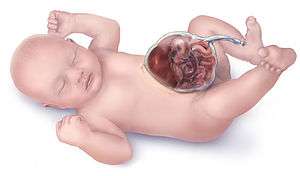Omphalocele
| Omphalocele | |
|---|---|
 | |
| Classification and external resources | |
| Specialty | medical genetics |
| ICD-10 | Q79.2 |
| ICD-9-CM | 756.72 |
| OMIM | 164750 |
| DiseasesDB | 23647 |
| MedlinePlus | 000994 |
| eMedicine | rad/483 |
| MeSH | D006554 |
Omphalocele, also spelled omphalocoele, is a rare abdominal wall defect in which the intestines, liver, and occasionally other organs remain outside of the abdomen in a sac because of failure of normal return of intestines and other contents back to abdominal cavity during around ninth week of intrauterine development.
Omphalocele occurs in 1/4,000 births and is associated with a high rate of mortality (25%) and severe malformations, such as cardiac anomalies (50%), neural tube defect(40%), exstrophy of bladder and Beckwith Wiedemann syndrome. Approximately 15% of live-born infants with omphalocele have chromosomal abnormalities. About 30% of infants with an omphalocele have other congenital abnormalities.
Signs and symptoms
The sac, which is formed from an outpouching of peritoneum, protrudes in the midline, through the umbilicus (navel).
It is normal for the intestines to protrude from the abdomen, into the umbilical cord, until about the tenth week of pregnancy, after which they return to inside the fetal abdomen.
The omphalocele can be mild, with only a small loop of intestines present outside the abdomen, or severe, containing most of the abdominal organs. In severe cases surgical treatment is made more difficult because the infant's abdomen is abnormally small, having had no need to expand to accommodate the developing organs.
Larger omphalocele are associated with a higher risk of cardiac defects.[1]
Screening
An omphalocele is often detected through AFP screening or a detailed fetal ultrasound. Genetic counseling and genetic testing such as amniocentesis are usually offered during the pregnancy.
Causes
Caused by malrotation of the bowels while returning to the abdomen during development. Some cases of omphalocele are believed to be due to an underlying genetic disorder, such as Edward's syndrome (trisomy 18)[2][3] or Patau syndrome (trisomy 13).
Beckwith–Wiedemann syndrome is also associated with omphaloceles.
Related conditions
Gastroschisis is a similar birth defect, but in gastroschisis the umbilical cord is not involved and the lesion is usually to the right of midline. Parts of organs may be free in the amniotic fluid, and not enclosed in a membranous (peritoneal) sac. Gastroschisis is less frequently associated with other defects than omphalocele.
Omphaloceles occurs more frequently with increased maternal age.
Other related syndromes are Pentalogy of Cantrell, Beckwith-Wiedemann, and OEIS complex (omphalocele, exstrophy of the cloaca, imperforate anus, spinal defects).
Society and culture
Awareness Day
International Omphalocele Awareness Day is celebrated annually on January 31, as part of Birth Defect Awareness Month. Several U.S. states have passed resolutions to officially recognize the date.[4][5][6][7][8]
References
- ↑ "Impact of omphalocele size on associated conditions". Journal of Pediatric Surgery. 43: 2216–2219. doi:10.1016/j.jpedsurg.2008.08.050.
- ↑ Kanagawa SL, Begleiter ML, Ostlie DJ, Holcomb G, Drake W, Butler MG (2002). "Omphalocele in three generations with autosomal dominant transmission". J. Med. Genet. 39 (3): 184–5. PMC 1735073
 . PMID 11897819. doi:10.1136/jmg.39.3.184.
. PMID 11897819. doi:10.1136/jmg.39.3.184. - ↑ Yatsenko SA, Mendoza-Londono R, Belmont JW, Shaffer LG (2003). "Omphalocele in trisomy 3q: further delineation of phenotype". Clin. Genet. 64 (5): 404–13. PMID 14616763. doi:10.1034/j.1399-0004.2003.00159.x.
- ↑ http://www.arkleg.state.ar.us/assembly/2015/2015R/Bills/HR1006.pdf, House Resolution 1006, State of Arkansas
- ↑ https://legiscan.com/CA/text/SR56/2015, California Senate Resolution 56
- ↑ http://www.legis.ga.gov/Legislation/en-US/display/20152016/HR/1171, Georgia House Resolution
- ↑ http://www.legislature.mi.gov/%28S%28h332eyphewi4vrrkhozpaomq%29%29/mileg.aspx?page=getObject&objectName=2016-HR-0209, Michigan House Resolution 0209
- ↑ http://www.nebraskalegislature.gov/FloorDocs/104/PDF/Intro/LR21.pdf, Nebraska Legislative Resolution 21
External links
- Omphalocele Diagnosis and Treatment at SSM Health St. Louis Fetal Care Institute
- The Brown Fetal Treatment Program - Providence, Rhode Island at Brown University
- Fetal Treatment Center: Omphalocele at UCSF
- Gastroschisis Exomphalos Extrophies Parent Support (GEEPS)